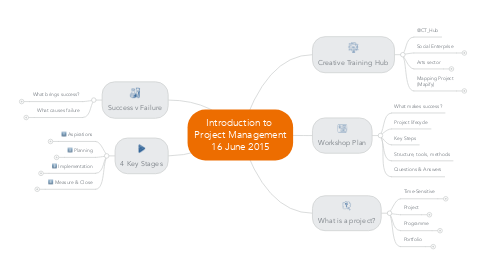
1. Success v Failure
1.1. What brings success?
1.1.1. Clear goal
1.1.1.1. Aligned with strategy
1.1.1.2. SMART Objectives
1.1.1.2.1. Specific
1.1.1.2.2. Measurable
1.1.1.2.3. Achievable
1.1.1.2.4. Realistic
1.1.1.2.5. Timed
1.1.1.3. What impact?
1.1.2. Good team
1.1.2.1. Skills
1.1.2.1.1. Identify skills required first
1.1.2.2. Know the members
1.1.2.3. Complementary
1.1.2.4. Trust them in roles
1.1.3. Connecting Dots
1.1.3.1. Communication
1.1.3.2. Clear line management
1.1.4. Managing stakeholders
1.1.4.1. Hecklers
1.1.4.2. Promoters
1.1.4.3. Supporters
1.1.4.4. Saboteurs
1.1.4.4.1. Deliberate
1.1.4.4.2. Accidental
1.1.5. Adaptability
1.2. What causes failure
1.2.1. Lack of buy-in
1.2.1.1. Internal
1.2.1.2. External
1.2.2. Grey areas
1.2.3. Scope creep
1.2.4. Unrealistic goals
1.2.5. Lack of measurement
1.2.6. Poor expectation management
1.2.7. Bottle necks
1.2.8. Failure to learn lessons
1.2.8.1. Failure to ask tough questions
1.2.8.2. Confront the brutal facts
2. 4 Key Stages
2.1. Aspirations
2.1.1. What are these based on?
2.1.1.1. Opportunism?
2.1.1.2. Or organisational goals?
2.1.2. Feasibility Studies
2.1.3. Kick-off meetings
2.1.3.1. Get together in person
2.1.3.2. Gather all ideas
2.1.3.3. Identify key questions
2.1.3.4. Build understanding
2.1.4. Key questions?
2.1.4.1. Why project is needed?
2.1.4.2. What's problem to be solved?
2.1.4.3. Who wants to see change?
2.1.5. Can you nail down one clear overall objective
2.2. Planning
2.2.1. Key Questions
2.2.2. Top 3 Milestones
2.2.3. Too many 'top priorities'
2.2.4. Aligning objectives
2.2.5. Metrics that matter
2.2.6. Risk log
2.3. Implementation
2.3.1. WBS
2.3.1.1. Tool to track progress
2.3.1.2. Clarify key points
2.3.1.2.1. Reducing wordiness
2.3.1.2.2. Hierarchy and order
2.3.1.3. Delegate tasks
2.3.1.4. Communicate with team
2.3.2. Managing your team
2.3.2.1. Forming
2.3.2.1.1. Getting to know
2.3.2.1.2. Who's who
2.3.2.1.3. Who's doing what
2.3.2.2. Storming
2.3.2.2.1. Jostling for position
2.3.2.2.2. Hecklers emerging
2.3.2.2.3. Possible coaching required
2.3.2.2.4. Lack of clarity
2.3.2.3. Norming
2.3.2.3.1. Everyone on board
2.3.2.3.2. One vision/plan
2.3.2.3.3. Focused and supportive
2.3.2.4. Performing
2.3.2.4.1. Competent
2.3.2.4.2. Confident
2.3.3. Risk Management
2.3.3.1. Identify
2.3.3.2. Qualify
2.3.3.2.1. Scoring
2.3.3.2.2. Likely to happen?
2.3.3.2.3. What is the impact?
2.3.3.3. Evaluate
2.3.3.4. Mitigate
2.3.4. Stakeholder Management
2.3.4.1. Decision Makers
2.3.4.2. Direct Influencers
2.3.4.3. Indirect Influencers
2.3.4.4. Observers
2.4. Measure & Close
2.4.1. How will you record data?
2.4.1.1. Change log
2.4.1.2. Stakeholder list
2.4.1.3. Risk log
2.4.2. Strategic objectives met?
2.4.3. Efficiency & productivity?
2.4.4. Budget and ROI
2.4.5. Handover
2.4.5.1. Are you handing over in best state?
2.4.5.2. Comprehensive resources/docs
3. Creative Training Hub
3.1. @CT_Hub
3.2. Social Enterprise
3.2.1. Heavy Arts focus
3.2.2. Community focus
3.3. Arts sector
3.3.1. Dependent on funding
3.3.2. Business principles lacking
3.4. Mapping Project (Mapify)
3.4.1. Connect Arts organisations
4. Workshop Plan
4.1. What makes success?
4.2. Project lifecycle
4.3. Key Steps
4.4. Structure, tools, methods
4.5. Questions & Answers
5. What is a project?
5.1. Time-Sensitive
5.1.1. Problem that is scheduled to be solved
5.1.2. Designed to achieve specific goal
5.2. Project
5.2.1. Outcome often unique and not repeated
5.3. Programme
5.3.1. Collection of interdependent projects
5.4. Portfolio
5.4.1. All active programmes
5.4.2. All active projects
5.4.3. Aligned with organisation strategy & objectives
